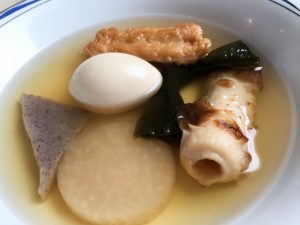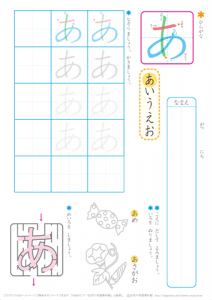RYUSITE

This week’s weather was quite warm for November, but when it is a little bit colder, everyone starts thinking about eating something hot, like “oden”, or going to Japanese onsen, or simply putting on something warm and getting under a kotatsu table. :))
So, as we all live in Japan for quite long, our tastes have been changed and we started craving the same food at exact same time, as many Japanese. Lol! 🙂
Sounds really very funny, but the reality is that Japanese food is not only healthy, it’s really very tasty! So today we wanted to talk about food, and we are going to start with “oden”!
Do You Know What Oden Is
Do you know what oden is?
Oden – is a sort of “nimono ryori”, or boiled or steamed dishes. It looks like a soup with all sorts of litte pieces of veggies, tofu, eggs, sausages and other tasty things, put on sticks and put into the cooking pan.
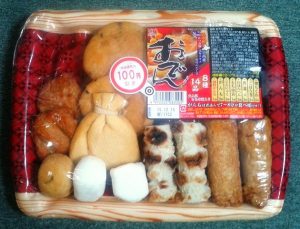 If you go to a nearest supermarket, you will easily find already-made sets of ingredients for an oden soup. It’s very convenient for working moms when you don’t have time for cooking, but still you want to eat something healthy and good. It only takes about 10~15 minutes to cook an oden from this set, so it’s very easy even for a man to cook it.
If you go to a nearest supermarket, you will easily find already-made sets of ingredients for an oden soup. It’s very convenient for working moms when you don’t have time for cooking, but still you want to eat something healthy and good. It only takes about 10~15 minutes to cook an oden from this set, so it’s very easy even for a man to cook it.
Simply put all ingredients into a water, where you previously add the sauce that comes with a set, and put a pan on a gaz. Put a lid on a pan, and wait. That’s it!
Now, if you are in a hurry and are not into cooking, you may prefer to simply check up your nearest convenience store for oden. Just in front of a cashier desk you will find an open square size big pan, where you will see separate sections and different pieces of oden in each of them. Each piece has its price, and the most cheap is actually udon ( Japanese rice noodles)! It’s not quite oden, but you can buy it here with oden soup, oden vegetables or sausages or meat.
your nearest convenience store for oden. Just in front of a cashier desk you will find an open square size big pan, where you will see separate sections and different pieces of oden in each of them. Each piece has its price, and the most cheap is actually udon ( Japanese rice noodles)! It’s not quite oden, but you can buy it here with oden soup, oden vegetables or sausages or meat.
As a matter of fact, I personally prefer having a cup of oden soup with udon, an egg and a piece of daikon (Japanese radish)! I also love to have a “mochi-iri kinchaku” in my oden, a sort of a drawstring looking bag made of aburaage, with a piece of rice mochi in it. If you make such an order at your nearest Lawson, it will cost you about ¥420, and you will be full. For those who love to save, look for discount dates, when all pieces of your oden will be for ¥80!
For foodies we have all sorts of oden’ya restaurants and small eating places all over Japan, so feel free to check them at your convenience!
Ok, so what to do if you would actually like to cook oden nabe at home for a party?
Oden Traditional Recipe
Here’s a simple recipe for a traditional Japanese oden dish.
Oden is made of many ingredients, with vegetables, fish, tofu, meat among them, and a simple dinner with oden bowl, rice and some vegetable salad would cover almost 100 % of an average 30-year old man daily diet in proteins, calcium and iron, basic vitamins and minerals. The calories are pretty low, so there is no worry of overeating and or putting on any extra weight.
Set up 45 minutes of your time to cook the dish and about 15~20 minutes to prepare the ingredients.
To cook oden you will need:
< Dashi> basic soup
Dashi jiru 3000ml
You can find an easy soup base at a supermarket, either in a liquid or powder form. They call it “oden-no-moto” (おでんの素), you simply dilute it in water as written in the description.
<Ingredients>
boiled eggs 4pcs
konnyaku 1pcs
fried chikuwa 1 pack
chikuwa-bu 1 pack
hanpen 1 pack
age-boru(fried fish balls) 1 pack
satsuma-age 1 pack
tsumire 1 pack
kibun-tsumire 1 pack
tied kelp 4 pcs
mustard a little
============
Daikon and eggs should be boiled in advance, so that they can soak more of oden soup when cooking.
Once you put a pan on fire and add dashi, wait until it starts boiling and add ingredients in this sequence: chikuwa, daikon, eggs and konnyaku, and boil for 30 minutes.
Once they become soft, add other ingredients such as fried chikuwa, age-boru, tsimire, satsuma-age, kelp and boil for another 5 minutes.
Add the rest of ingredients ( except hanpen ) and boil for 10 minutes. At last put hanpen in and boil for 1-2 minutes until it gets big, and then stop the fire.
Put a pan on a middle of the table and enjoy the meal with your friends and family!
Well done!
If you couldn’t understand some of the expressions, you might want to check out some of our short-term Japanese language programs for foreigners and international students, who visit Japan on a tourist visa, or work or stay here, for more Japanese language practice and for learning more about Japanese culture and life-style while enjoying various in and out of class activities.
We also would like to hear your feedback and appreciate comments, likes and shares.
In our next article we are going to continue with food-topics and you can come back to explore more. Stay tuned!

Teaching Japanese as a foreign language may seem to be something very alien and unusual, but in reality we had a few inquiries from international students who are interested in following this career.
So today we are concerned to find out whether it is possible for a non-native Japanese speaker (a foreigner), to become a Japanese language teacher and start teaching Japanese as a second language back in their home country or somewhere else in the world.
Japanese as a second Language Teacher Certificate
First of all, let’s explore if there is any sort of certification you need to be aware of when you are looking to start your career as a Japanese language teacher.
As we are now in Japan, let’s start with Japanese certification system and what is required for anyone who wants to become a teacher.
After making our research we found that for Japanese nationals (Japanese native speakers) there aren’t any national qualifications that a person needs to acquire if he/she wants to become a teacher of Japanese as a foreign language. However, for Japanese there are certain conditions and they are as follows:
- Japanese Training Course (420 hours)
- Japanese Language Teaching Competency Test (日本語教育能力検定試験)
- Specialized Japanese Language Teacher Class at a Japanese University
Japanese native speakers (Japanese nationals) are required to complete one of the above requirements in order to work as a Japanese language teacher here in Japan.
They can choose either option available to be seen as a certified teacher and to get a job.
Is It Possible for a Foreigner to Become a Teacher of Japanese?
The answer is yes, it is definitely possible, if you are ready to put enough time and effort to achieve your study and professional goals.
If you are an international student, the requirements for you will be the same, but before that you must become really proficient in Japanese in order to apply to one of the above options or to pass a specific teacher’s test.
The minimum requirement for all of the above options is to have at least JLPT N1 level of proficiency in Japanese and know the language well.
If You Choose Option 1
If an international student chooses option 1 and is willing to join the course to become a teacher of Japanese as a foreign language, he/she needs to show evidence of proficiency (JLPT N1) , plus to sit at an interview with school counselors. Finally they will decide if the student is ready for the course or not.
How long does it take to complete these 420 hours? They usually take a 1 year course, or an alternative 6 months intensive course. And this is without counting those 2 years or more that any international student needs to spend to reach JLPT N1 level of Japanese proficiency.
If You Choose Option 2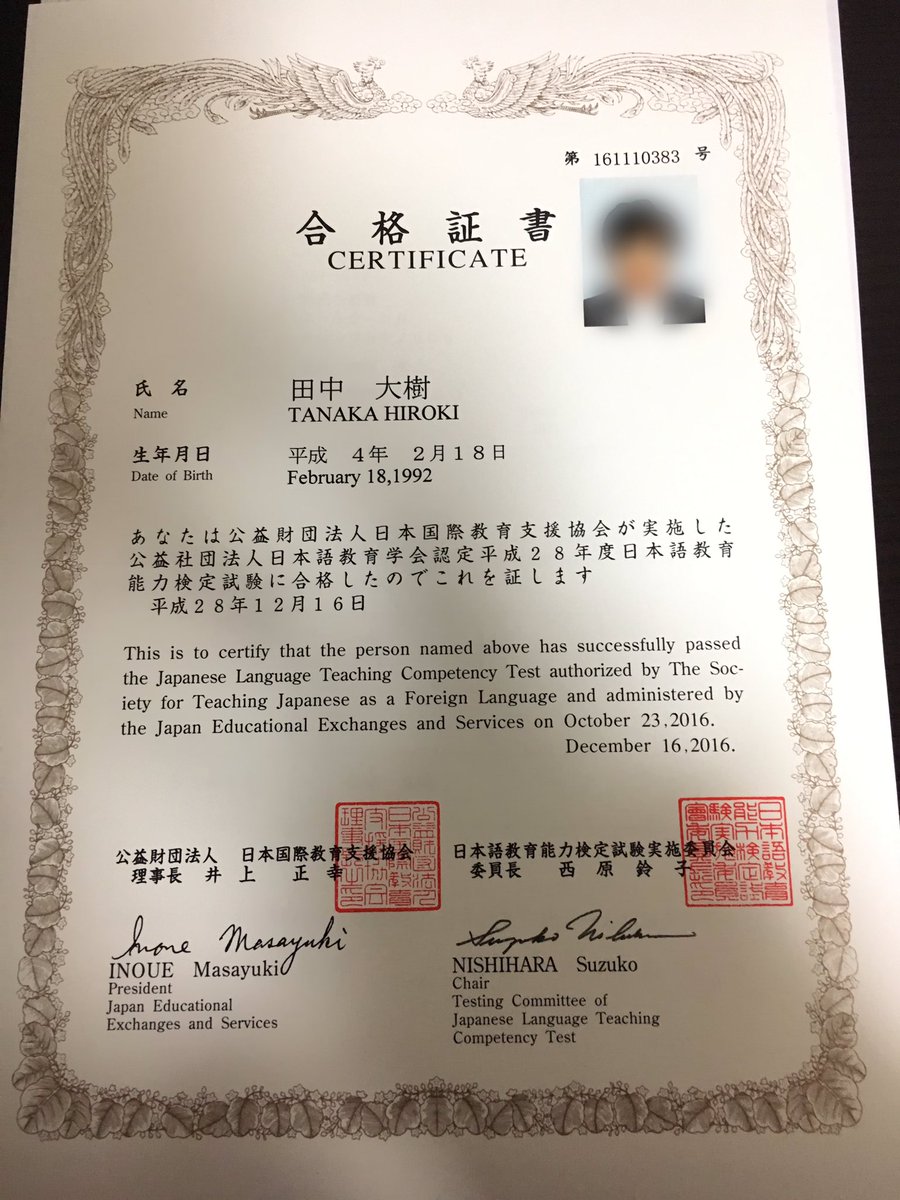
Again, here an international student has to possess fluency in Japanese language in order to take the test.
The test is held once a year in October, and students can take it in following locations: Sapporo, Sendai, Tokyo, Nagoya, Osaka, Hiroshima and Fukuoka.
The test consists of 3 parts (90 min/writing, 30 min/listening, 120 min/writing), and refers to the knowledge of Japanese society, culture, history of education, language + society, language + psychology, language + education; general language and such topics. The student has to prove his/her knowledge of not only the language and linguistics, but also the behavioral habits, psychology and such.
Statistics show that 6,167 students have applied in 2016 to take the test, but only 4,934 students have been able to actually sit the test. And only 1,231 students have passed and gotten the certificate. That makes about 25% of pass rate. And here we talk about Japanese native speakers, not international, as we couldn’t find any statistics about international students taking this test.
This option seems to be the best for foreigners who already live in Japan and have other types of visas, than a student visa status. Applicants have no limitations, and anybody can apply to take this test, so the visa status does not matter.
※Statistics information for 2016 can be found here. (Japanese)
If You Choose Option 3
This option seems to be the best option for international students! Why is that? Because you can take a 1 or 2 year course at one of our partner Japanese language schools in your favorite place in Japan, and then continue your education as an international student at a University, taking this specific teacher’s course, studying together with Japanese students.
This is not only doable in terms of length of study, but also this way it’s easy to maintain your international student visa status, as schools will help arranging all that for you.
Also by choosing this option, you can get not only a teacher’s certificate, but actually a degree from one of Japanese higher education institutions, that will boost your career soon after from your graduation!
Let us know if you are interested to learn more by leaving your inquiry here.
We also appreciate our readers who choose to stay up to date with Motivist Japan news on social media, so we invite you too!
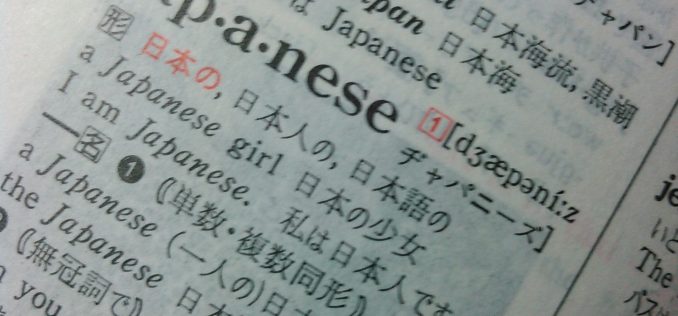
Today we are going to continue our series of articles on learning Japanese for beginners, and this is a second part of the JLPT N5 basics. If you have missed the first part, you can check it here: Learning Japanese Basics: Inside JLPT N5 (Part 1).
JLPT N5 Part 2: Grammar
JLPT N5 consists of about 80~100 kanji that a student has to learn to be able to pass this level. However, when we talk about vocabulary, here we have even more words to learn, about 800~1000! And we also have new grammar structures, that students have to learn and to be able to recognize and use properly.
First of all, let’s start with grammar and here is the list of articles and grammar specific structures a student needs to learn in JLPT level N5. We didn’t use the kanji, so it’s easy for beginners to read and memorize, and we also gave English alphabet transcription as well as the meaning in English. Enjoy!

すわっておうえんしましょう / Norisa1
1. ~です
これはリンゴです。(Kore wa ringo des / This is an apple.)
2. ~も~
私はリンゴもバナナも好きです。(Watashi wa ringo mo, banana mo suki des. / I like apples, as well as bananas. )
かれはブドウもすきです。(Kare wa budo mo suki des. / He also likes grapes. )
3. ~で~
外で待ちましょう。(Soto de machimasho. / Let’s wait outside. )
4. ~に~/~へ~
昨日、銀行へ行きました。(Kino ginko he ikimashita. / Yesterday I went to the bank.)
明日、映画を見に行きましょう。(Ashita, eiga wo mi ni ikimasho. / Let’s go to the movies tomorrow. )
5. ~に~
つくえの上にえんぴつがあります。(Tsukue no ue ni enpitsu ga arimas. / There is a pencil on the table. )
6. ~を~
友達に電話をかけます。(Tomodachi ni denwa wo kakemas. / I am going to phone my friend. )
7. ~ませんか
明日、映画を見に行きませんか。(Ashita, eiga wo mi ni ikimasenka. / Would you like to go to the movies tomorrow?)
8. ~は~
今日は暑いです。(Kyo wa atsui des. / Today (the weather) is hot. )
9. ~があります
銀行のとなりに学校があります。(Ginko no tonari ni gakko ga arimas. / There is a school next to the bank.)
10. ~がいます
あそこにいぬがいます。(Asoko ni inu ga imas. / There is a dog over there.)
11. ~と~
かれは音楽とサッカーがすきです。(Kare wa ongaku to sakkka ga suki des. / He likes music and soccer.)
12. ~ましょう
ごはんを食べましょう。(Gohan wo tabemasho. /Let’s eat rice. /Let’s eat.)
公園へ行きましょう。(Koen he ikimasho. / Let’s go to the park.)
13. ~ましょうか
しゅくだいをしましょうか。(Shukudai wo shimasho ka. / Shall we do homework./ Let’s do homework./ How about doing homework?)
リンゴをたべましょうか。(Ringo wo tabemasho ka. / Let’s eat apples.)
14. ~てください
てつだってください。(Tetsudatte kudasai./Please help me.)
はらってください。(Haratte kudasai./Please pay.)
15. ~てもいいです
話してもいいです。(Hanashite mo ii des./You can talk./ It’s ok to talk.)
あそんでもいいです。(Asonde mo ii des./You can play./It’s ok to play.)
16. ~てはいけません
あそんではいけません。(Asonde wa ikemasen. / You can’t play./It’s not ok to play./ You must not play.)
17. ~から~
昨日からちょうしわるいです。(Kino kara choshi warui des. / I feel not well since yesterday.)
しごとからかえりました。 (Shigoto kara kaerimashita. / I came back from work.)
18. ~ている
知っている(Shitteiru / Know about)
ひらいている (Hiraiteiru / Is open)
19. ~にいく
かいものにいく。(Kaimono ni iku./Going shopping.)
20. ~ないでください
しないでください。(Shinaide kudasai./ Please don’t do ~/ Please stop.)
おこらないでください。(Okoranaide kudasai. / Please don’t be angry.)
21. ~のがすきです
たべるのがすきです。(Taberu no ga suki des. / I like eating.)
うたうのはすきです。(Utau no ga suki des./ I like singing.)
22. ~のがじょうずです
かのじょはうたうのがじょうずです。(Kanojo wa utau no ga jouzu des. / She is good at singing.)
23. ~のがへたです
かれはおよぐのがへたです。(Kare wa oyogu no ga heta des. / He’s not good at swimming)
24. まだ~ていません
あおきさんはまだきていません。(Aoki san wa mada kite imasen. / Mr.Aoki is not here yet./ Mr.Aoki hasn’t come yet.)
25. ~のほうが~より~
たけしは魚のほうがお肉より好きです。(Takeshi wa sakana no hou ga oniku yori suki des./ Takeshi likes fish better than meat.)
26. ~のなかで~がいちばん~
犬のなかでは、プードルがいちばんかわいいです。(Inu no naka de wa, pu-doru ga ichiban kawaii des./ Poodles are the most cute among all dogs.)
クラスのなかでは、マリアさんがいちばん日本語がじょうずです。/Maria is the best in Japanese in our class.)
27. ~つもりです
学校かえりでかいものへ行くつもりです。(Gakko kaeri de kaimono he iku tsumori des./ I’m planning to go shopping after school.)
28. ~く/ ~になる
3に2をくわえると5になる。(San ni ni wo kuwaeru to go ni naru./Add 2 to 3 and you have 5.)
29. ~たいです
おどりたいです。(Odoritai des./I want to dance.)
かえりたいです。(Kaeritai des./I want to go home./I want to go back.)
30. ~たり 、~たりする
あめがふったり、やんだりすることがある。(Ame ga futtari, yandari suru koto ga aru./ It can rain and stop raining.)
31. ~たことがある
日本からのおみやげをおくったことがある。(Nihon kara no omiyage wo okutta koto ga aru./I have sent presents from Japan.)
32. ~や~
かのじょのへやにはベッドや机などがあります。(Kanojo no heya ni wa beddo ya tsukue nado ga arimas./She has a bed and a table in her room.)
33. ~んです
どうしたんですか(Dou shita n des ka./What happened?)
ころんだんです (Korondandes. / I fell down.)
34. ~すぎる
このバッグは大きすぎる!(Kono baggu wa ookisugiru!/This bag is too big!)
35. ~ほうがいい
あそこのレストランのほうがいい。(Asoko no resutoran no hou ga ii./That restaurant seems better.)
36. ~ので~
このへやは、えきからちかいので、やちんがたかい。(Kono heya wa, eki kara chikai node, yachin ga takai./ This room is close to the station, that’s why the rent is high.)
37. ~なくちゃいけない
どようびいそがしいので、きょうそうじをしなくちゃいけない。(Doyobi isogashii node, kyo souji wo shinakuchaikenai./ I am going to be busy on Saturday, so have to/need to clean the house today.)
38. ~でしょう
あしたはさむくなるでしょう。(Ashita wa samuku naru desho./It’s going to be cold tomorrow.)
ともだちがくるでしょう。(Tomodachi ga kuru desho./A friend is going to come.)
39. ~まえに
学校へいくまえにあさごはんをたべます。(Gakko he iku mae ni asagohan wo tabemas./I eat breakfast before going to school.)
40. ~てから
かいものをしてからゆうしょくをつくります。(Kaimono wo shite kara yuushoku wo tsukurimas. / I am going to cook dinner after shopping.)
We tried to give you some easy examples along with these grammar sentences, but of course this is not everything you can learn in JLPT N5.
We recommend our students to at least study for JLPT level N5 before coming to Japan, but it is not necessary. Many of our partner Japanese language schools offer classes for beginners starting with zero knowledge of Japanese, so please don’t worry!
All our partner schools provide specific Japanese language education for international students, done by professionally trained teachers. By taking one of the short or long-term programs our students save months and years on studying Japanese language, if done by yourself alone, and this is probably the main benefit of studying at one of Japanese Language Schools here in Japan!
For more information, simply fill up this inquiry form, and we will contact you back asap.
And of course stay tuned to our next coming article, JLPT N5 Part3.
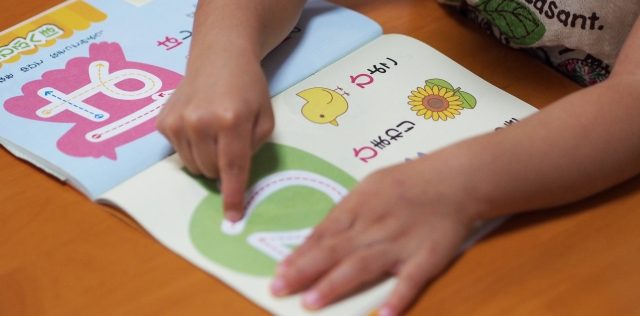
Today we are starting out a series of articles, where we are going to discuss topics related to learning Japanese language. And as today is our first day of the series, we are going to focus on basics. 🙂
We suppose that you, as our reader, are interested in learning Japanese language and in coming to Japan one day. So specifically for you we have started these series, because we want you to feel a little bit more comfortable when approaching and actually starting out to learn this language. And by the way, it is not as difficult as it may seem!
Basics – they are always basics. You cannot skip them. You need to simply learn them. It doesn’t matter what language you are currently learning, you need to learn and memorize basics, period.
However, we don’t want to discourage anyone who is about to start learning Japanese and would like to give our readers some ideas and outlines for starting off on the right foot.
Also we are going to tap into what is that you need to know if you are planning to finally pass that beginner level JLPT N5 exam. And why JLPT N5 by the way? Because this level is all about basics, and this is the first mountain you need to climb if you are dedicated to reach Japanese language mastery one day. 🙂
JLPT Level N5: What’s In It?
For those who are new here, JLPT stands for Japanese Language Proficiency Test and you can read more about it on its official page here.
There are 5 levels overall from N5 (beginner) to N1 (advanced), and each level consists of corresponding level of vocabulary, grammar, reading comprehension and kanji.
You can think of Level N5 as your 1~2 years at an elementary school here in Japan! Like little kids here you will start from learning the alphabet, and there are two by the way for those who don’t know, called hiragana and katakana. Children usually learn how to write these letters, the structure of simple kanji (Japanese characters), first wording etc.
Pronunciation of Japanese is actually easy, anyone can learn how to pronounce it right. The easy part is that you pronounce what you see! In some languages, like for example in Russian, you see one letter, but you pronounce it completely differently. In English there are nasal or liaison sounds, which are also difficult for non-native learners. In Japanese there are practically no such things and everything is pretty much easy. You read what you see and as you see it!
Now, the difficult part starts with memorizing new words (like in any language you are about to learn for the first time). For westerners, there are almost no connection between our native languages and Japanese, so words themselves are quite difficult to memorize. But once you get a feel of them, it all becomes easier! Practice, practice, practice!))
We are going to give you a list of words you need to learn to pass JLPT N5 in our later articles, but for now we wanted to give you a simple overview on what to expect.
Now, let’s take the next step after learning the alphabet and first words. This time we are talking about Japanese characters, or kanji (漢字).
Japanese kanji are structured the way that they look like pictures.  So for example, if you take the word 木(き)or “ki” , that means “a tree”, you can get an image of a tree standing alone. When you look at a word 林(はやし)or “hayashi”, that means “a forest”, now you can see 2 trees standing in a row. So you get an image of a forest that is actually easy to memorize! And at last let’s take a 森(もり)or “mori” character, that means “woods”. Now you can see plenty of trees gathered together making some woods! :)
So for example, if you take the word 木(き)or “ki” , that means “a tree”, you can get an image of a tree standing alone. When you look at a word 林(はやし)or “hayashi”, that means “a forest”, now you can see 2 trees standing in a row. So you get an image of a forest that is actually easy to memorize! And at last let’s take a 森(もり)or “mori” character, that means “woods”. Now you can see plenty of trees gathered together making some woods! :)
With Japanese and its characters kanji it’s all about images and imagination! Each character has a sense and a meaning, and if you can catch what it represents, it will be much easier for you to understand and finally learn and memorize those kanji.
JLPT N5 Kanji List
Here is a simple list of kanji in JLPT level N5 you need to learn to pass this level (total 80 characters)
Number characters: 一 二 三 四 五 六 七 八 九 十 百 千 万
Time related: 今 前 後 半 午 先 分 年 日 時 月 毎 年
Days of the week: 月 火 水 木 金 土 日
Direction: 北 南 西 東 右 左 外 中 上 下
People related: 子 女 男 母 父 人 友 名
School related: 学 校 書 読 語 聞 小 中 高 本
Nature related: 山 川 雨 電 天 土
Verbs, other: 入 出 円 国 大 小 来 気 白 行 見 話 読 車 金 長 食
If you are already in Japan, it would be a good idea to buy a writing practice book for elementary school children and practice tracing alphabets and simple kanji. It’s really an easy and fast way to learn how to write and to write correctly.
If you don’t have an opportunity to come to Japan yet, why not checking our services and finding a right course for you to study. We help international students to easily organize their study tours to Japan for no charge, and this is a great opportunity for you to come here and learn Japanese language in Japan!
Today we’ve discussed what is involved in starting learning Japanese language from scratch, and this is:
- Get ready to be serious!
- Find your purpose for study
- Learn the basics
- Challenge to pass the JLPT N5 exam
- You are now ready to go to Japan for study/work/travel!
- Enjoy the process to mastery
In the next article we are going to help our readers, who would like to get a sense what is this to be able to speak Japanese, to continue grasping the basics and we are going to help you understand the basic sentence structure and will teach you the very common sentences you can start using in your daily life. So stay tuned!
We also appreciate comments, FB likes and Twitter following. Let us know what you are interested to hear next!





